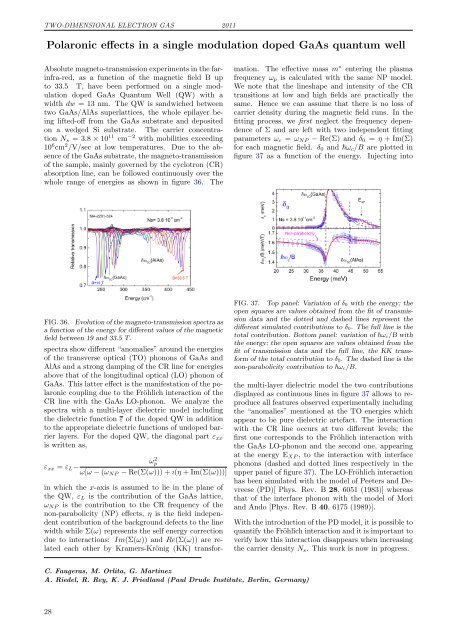2011 - Laboratoire National des Champs Magnétiques Intenses ...
2011 - Laboratoire National des Champs Magnétiques Intenses ...
2011 - Laboratoire National des Champs Magnétiques Intenses ...
Create successful ePaper yourself
Turn your PDF publications into a flip-book with our unique Google optimized e-Paper software.
TWO-DIMENSIONAL ELECTRON GAS <strong>2011</strong>Polaronic effects in a single modulation doped GaAs quantum wellAbsolute magneto-transmission experiments in the farinfra-red,as a function of the magnetic field B upto 33.5 T, have been performed on a single modulationdoped GaAs Quantum Well (QW) with awidth dw = 13 nm. The QW is sandwiched betweentwo GaAs/AlAs superlattices, the whole epilayer beinglifted-off from the GaAs substrate and depositedon a wedged Si substrate. The carrier concentrationN s = 3.8 × 10 11 cm −2 with mobilities exceeding10 6 cm 2 /V/sec at low temperatures. Due to the absenceof the GaAs substrate, the magneto-transmissionof the sample, mainly governed by the cyclotron (CR)absorption line, can be followed continuously over thewhole range of energies as shown in figure 36. Thein which the x-axis is assumed to lie in the plane ofthe QW, ε L is the contribution of the GaAs lattice,ω NP is the contribution to the CR frequency of thenon-parabolicity (NP) effects, η is the field independentcontribution of the background defects to the linewidth while Σ(ω) represents the self energy correctiondue to interactions: Im(Σ(ω)) and Re(Σ(ω)) are relatedeach other by Kramers-Krönig (KK) transformation.The effective mass m ∗ entering the plasmafrequency ω p is calculated with the same NP model.We note that the lineshape and intensity of the CRtransitions at low and high fields are practically thesame. Hence we can assume that there is no loss ofcarrier density during the magnetic field runs. In thefitting process, we first neglect the frequency dependenceof Σ and are left with two independent fittingparameters ω c = ω NP − Re(Σ) and δ 0 = η + Im(Σ)for each magnetic field. δ 0 and ω c /B are plotted infigure 37 as a function of the energy. Injecting intoFIG. 36. Evolution of the magneto-transmission spectra asa function of the energy for different values of the magneticfield between 19 and 33.5 T.spectra show different “anomalies” around the energiesof the transverse optical (TO) phonons of GaAs andAlAs and a strong damping of the CR line for energiesabove that of the longitudinal optical (LO) phonon ofGaAs. This latter effect is the manifestation of the polaroniccoupling due to the Fröhlich interaction of theCR line with the GaAs LO-phonon. We analyze thespectra with a multi-layer dielectric model includingthe dielectric function ε of the doped QW in additionto the appropriate dielectric functions of undoped barrierlayers. For the doped QW, the diagonal part ε xxis written as,ε xx = ε L −ω[ω − (ω NP − Re(Σ(ω))) + ı(η + Im(Σ(ω)))]ω 2 pFIG. 37. Top panel: Variation of δ 0 with the energy; theopen squares are values obtained from the fit of transmissiondata and the dotted and dashed lines represent thedifferent simulated contributions to δ 0. The full line is thetotal contribution. Bottom panel: variation of ω c/B withthe energy; the open squares are values obtained from thefit of transmission data and the full line, the KK transformof the total contribution to δ 0. The dashed line is thenon-parabolicity contribution to ω c/B.the multi-layer dielectric model the two contributionsdisplayed as continuous lines in figure 37 allows to reproduceall features observed experimentally includingthe “anomalies” mentioned at the TO energies whichappear to be pure dielectric artefact. The interactionwith the CR line occurs at two different levels; thefirst one corresponds to the Fröhlich interaction withthe GaAs LO-phonon and the second one, appearingat the energy E XP , to the interaction with interfacephonons (dashed and dotted lines respectively in theupper panel of figure 37). The LO-Fröhlich interactionhas been simulated with the model of Peeters and Devreese(PD)[ Phys. Rev. B 28, 6051 (1983)] whereasthat of the interface phonon with the model of Moriand Ando [Phys. Rev. B 40, 6175 (1989)].With the introduction of the PD model, it is possible toquantify the Fröhlich interaction and it is important toverify how this interaction disappears when increasingthe carrier density N s . This work is now in progress.C. Faugeras, M. Orlita, G. MartinezA. Riedel, R. Rey, K. J. Friedland (Paul Drude Institute, Berlin, Germany)28


